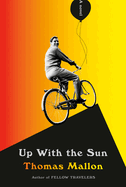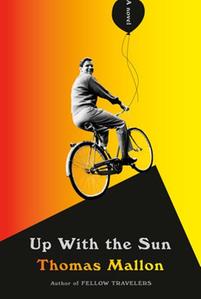
 Novelist Thomas Mallon has mastered the art of fictionalizing the lives of historical figures: Richard Nixon in Watergate, Ronald Reagan in Finale and so on. Dick Kallman--an American actor turned antiques dealer who was murdered in 1980--may not have been a prominent historical figure, but in Up with the Sun, Mallon leans on the not-quite star's biography to tell a story every bit as revealing about American ambition as the author's previous efforts centered on political giants.
Novelist Thomas Mallon has mastered the art of fictionalizing the lives of historical figures: Richard Nixon in Watergate, Ronald Reagan in Finale and so on. Dick Kallman--an American actor turned antiques dealer who was murdered in 1980--may not have been a prominent historical figure, but in Up with the Sun, Mallon leans on the not-quite star's biography to tell a story every bit as revealing about American ambition as the author's previous efforts centered on political giants.
The novel's even-numbered chapters unspool like a mystery. They're narrated by Matt Liannetto, a native New Yorker who makes his living as a pianist for musicals; he met Dick in 1951, when they were working on the same show. As it happens, Matt was at a dinner party at Dick's Manhattan duplex the night before Dick and his live-in boyfriend were fatally shot in what seems to have been a robbery gone wrong. Suspects are nabbed--sketchy men that Dick welcomed into his home as the evening was wrapping up--and Matt testifies at the trial, where he can't help but notice that his cheap-looking tiepin, which Dick foisted on him at the tail end of the party, catches the interest of the defendants.
In Old Hollywood parlance, Up with the Sun has a cast of thousands. There are delectable walk-ons as well as fully dramatized scenes featuring both famous faces (Natalie Wood, Robert Osborne) and stars of lower wattage. In a recurring role is actress Carole Cook, a real-life contemporary of Dick, who may be speaking for the reader when she wants to know why Matt seems to be obsessed with a man who is, as she put it, "not terribly likable as murder victims go."
Dick's unlikability is on hilariously preening display in Up with the Sun's odd-numbered chapters; an omniscient narrator remarks that with Dick, "ambition stuck out like a cowlick or a horn, fatal to an audience's complete belief in almost any character he was playing." These chapters trace Dick's life as a well-born striver whose many attempts to set Hollywood afire, most promisingly with the doomed sitcom Hank (1965-66), ended in crushing disappointment refashioned into rage. In one scene, Dick accidentally-on-purpose smashes costar Dyan Cannon's finger for upstaging him during a performance. The wonder of Mallon's characterization is that, for all of Dick's weaselly ways, he remains sympathetic--except when he crosses Lucille Ball. Then he's pushing it. --Nell Beram, author and freelance writer
Shelf Talker: Part mystery and part homage to showbiz also-rans, this sensational (in both senses) novel imagines the aftermath of real-life actor Dick Kallman's 1980 murder and the three decades that precede it.

